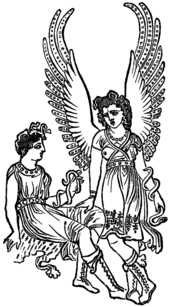
In Greek mythology the Erinyes (Ἐρινύες, pl. of Ἐρινύς, Erinys; literally "the avengers") from Greek ἐρίνειν " pursue, persecute"--sometimes referred to as "infernal goddesses" (Greek χθόνιαι θεαί)-- were female chthonic deities of vengeance. A formulaic oath in the Iliad invokes them as "those who beneath the earth punish whosoever has sworn a false oath".[1] Burkert suggests they are "an embodiment of the act of self-cursing contained in the oath".[2]
They correspond to the Furies or Dirae in Roman mythology.
When the Titan Cronus castrated his father Uranus and threw his genitalia into the sea, the Erinyes emerged from the drops of blood, while Aphrodite was born from the crests of seafoam. According to variant accounts,[3][4][5][6] they emerged from an even more primordial level—from Nyx, "Night". Their number is usually left indeterminate. Virgil, probably working from an Alexandrian source, recognized three: Alecto ("unnameable" who appeared in Virgil's Aeneid), Megaera ("grudging"), and Tisiphone ("vengeful destruction"). Dante followed Virgil in depicting the same three-charactered triptych of Erinyes; in Canto IX of the Inferno they confront the poets at the gates of the city of Dis. The waists of the Erinyes were entwined with serpents (compare Gorgon) and their eyes dripped with blood, rendering their appearance rather horrific. Other depictions show them with the wings of a bat or bird and the body of a dog.
In literature
In Aeschylus's Oresteia, the story is begun with Agamemnon's return home, to find that his wife, Clytemnestra, had married her lover, Aegisthus. Agememnon was slain by his wife. When Orestes, their son, reached manhood, he was commanded by one of Apollo’s oracles to avenge his father‘s murder at his mother’s hand. Orestes hastened to follow Apollo’s orders. He returned home and revealed himself to his sister. However, he pretended to be a messenger bringing the news of his death and slew Clytemnestra. Although Orestes’ actions were what the god Apollo had commanded him to do, Orestes had still committed matricide and because of this, he was pursued by the terrible Erinyes. They chased him relentlessly and upon reaching Delphi he was told by Apollo that he should go to Athens to seek Athena's aid; he did so and she arranged a trial. The Erinyes appeared as Orestes’ accusers, while Apollo spoke in defence. He was acquitted and after this process the Erinyes were satisfied by Athena's mixture of bribes and veiled threats. At this point Athena led a procession accompanying them to their new abode, with the escort now addressing them as "Semnai" (Venerable Ones), as they will now be honored by the citizens of Athens and ensure the city's prosperity.
In Euripides' Orestes they are for the first time "equated"[7] with the Eumenides (Εὐμενίδες, pl. of Εὐμενίς; literally "the gracious ones" but also translated as "Kindly Ones"[8][9])
In Sophocles's play, Oedipus at Colonus, it is significant that he comes to his final resting place in the grove dedicated to the Erinyes. It shows that he has paid his penance for his blood crimes, as well as come to integrate the balancing powers to his early over-reliance upon Apollo, the god of the individual, the sun, and reason. He is asked to make an offering to the Erinyes and complies, having made his peace.
Notes
| Greek deities series |
|---|
| Chthonic deities |
- ^ Iliad iii.278ff; xix.260ff
- ^ Burkert 1985, p. 198
- ^ Aeschylus Eumenides 321
- ^ Lycophron 432
- ^ Virgil Aeneid 6.250
- ^ Ovid Metamorphoses 4.453
- ^ Timothy Gantz, Early Greek Myth: A Guide to Literary and Artistic Sources, 1993, Johns Hopkins University Press, p832
- ^ Suid. s. v. Ἄλλα δ' ἀλλαχοῦ καλά
- ^ http://www.theoi.com/Khthonios/Erinyes.html
References
- Aeschylus, "Oresteia" Trans. Lloyd-Jones. Lines 788–1047.
- Homer, Iliad xiv.274–9; xix.259f.
- Virgil, Aeneid vii, 324, 341, 415, 476.
- Burkert, Walter, 1977 (tr. 1985). Greek Religion (Harvard University Press).
- Scull, S A. Greek Mythology Systematized. Philadelphia: Porter & Coates, 1880. Print.
- Wilk, Stephen R. Medusa: Solving the Mystery of the Gorgon. Oxford: Oxford University Press, 2000. Google Book Search. Web. 24 October 2011.
- Littleton, Scott. Gods, Goddesses, and Mythology, Volume 4. Marshall Cavendish Corporation, 2005. Google Book Search. Web. 24 October 2011.